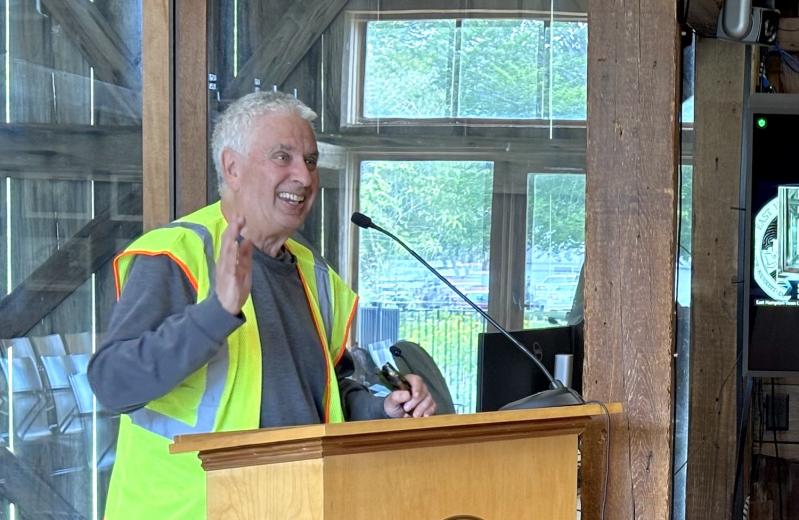Last year, after the East Hampton Town Board, hoping to reduce litter along roadsides, passed a law requiring trucks to cover their loads, Jaine Mehring and Christine Ganitsch, members of the town’s litter action committee, visited the dump to gauge compliance.
“We sat at the entrance for an hour and made notes on how many loads were coming in that were not secured or covered,” Ms. Mehring told the board on Tuesday. “Pretty much every truck that came in was not covered and not secured. We weren’t expecting the lack of compliance to be as profound as it was. We’re starting at zero in terms of knowledge of the code.”
The “cover your load” law includes a first-time penalty of $250. Councilman Tom Flight asked if any tickets had been issued, but Councilwoman Cate Rogers, the board’s liaison to the litter committee, said she didn’t have the data handy.
In a presentation by Ms. Ganitsch and Tina Plesset, another member of the committee, the board heard several recommendations on how littering could be reduced. These included an anti-litter campaign, a code amendment that would strengthen rental registry trash-hauling requirements, adding language to building permits about contractor responsibility for their garbage, engaging with the State Department of Transportation about improving litter removal along Route 27, and adding temporary signage, in English and Spanish, near recently cleaned areas and at the town transfer stations.
The committee identified other major sources of litter. In addition to uncovered truck loads, parking lots, trash receptacles, dumpsters at construction sites, and landscaper lunch debris are all problematic. Laws are already on the books addressing these hot spots, but enforcement is apparently lacking.
“I apologize if I’m blunt, but this makes me really angry,” said Mr. Flight. “People know this already. We know not to leave litter on the ground. I don’t think additional education is necessarily what we need. It runs a risk of us saying we’re doing something when actually we’re not.” He pushed for stronger enforcement, or even paying people to go out and pick up the garbage. “That is the only way, truthfully, we’re going to address this problem.”
Councilman David Lys wasn’t convinced. “The more you go out there and you pick it up, the more people say, someone else is going to do it.”
He suggested increasing the penalties for littering.
“We see the signs on the highway saying now it went from $250 to $1,000 for littering. I don’t think there’s been one ticket,” said Mr. Flight.
“We have talked back and forth about how difficult [enforcement] is,” said Ms. Plesset. “That’s why we always come back to the recycling stations, because when the trucks come in, if their loads aren’t covered and they get a ticket, this spreads the word that we’re serious about the enforcement.”
Just about everyone at the meeting complained about the ubiquitous green bags full of dog feces that are strewn around the town on trails, beaches, and in neighborhoods. They seem to be a particular problem at Sammy’s Beach in East Hampton. In February, the town decided to remove a trash receptacle there because it took sanitation employees 45 minutes out of their way to collect it. As a result, dog walkers were leaving their bags in a pile.
The committee recommended replacing the bins, but the board was against the idea.
“I own a dog. I have to pick up waste,” said Councilman Ian Calder-Piedmonte. “I am baffled by the idea that somebody would pick it up and then leave it there. I don’t want to just pretend that people can’t do a better job.”
Cameras, or targeted enforcement at dog-walking hot spots, could be an option. This could coincide with the adjacent issue of off-leash dogs at sensitive environmental areas like Sammy’s Beach, where there are piping plover and least tern nests. East Hampton Village passed a leash law not long ago, recognizing that owners are more likely to pick up dog waste when a leash is involved.
“If they insist on carry-in-carry-out at Sammy’s, they should remove the dog poop bag dispenser and forbid dogs,” wrote Sara Davison, another member of the litter action committee, in an email.
“I think that education is important, and the carrot-and-stick. The stick, I think, is not being used enough at all,” said Robert Brody, also a committee member.
“The challenge is, they are limited in their resources,” said Councilman Flight. “If it’s us giving that direction to code enforcement that ‘hey, this is now the priority more than . . . what?’ It requires investment one way or another on the town’s behalf to fix this problem. That’s one of the commitments we need to discuss as a town board. Is this worth it to us?”




